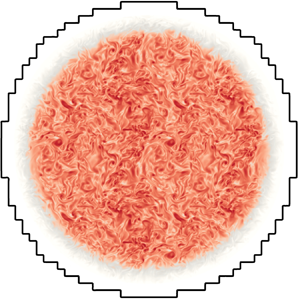Article contents
Dynamics and decay of a spherical region of turbulence in free space
Published online by Cambridge University Press: 27 November 2020
Abstract

We perform direct numerical simulation and large-eddy simulation of an initially spherical region of turbulence evolving in free space. The computations are performed with a lattice Green's function method, which allows the exact free-space boundary conditions to be imposed on a compact vortical region. Large-eddy simulations are conducted with the stretched vortex subgrid stress model. The initial condition is spherically windowed, isotropic homogeneous incompressible turbulence. We study the spectrum and statistics of the decaying turbulence and compare the results with decaying isotropic turbulence, including cases representing different low-wavenumber behaviour of the energy spectrum (i.e.  $k^2$ versus
$k^2$ versus  $k^4$). At late times the turbulent sphere expands with both mean radius and integral scale showing similar timewise growth exponents. The low-wavenumber behaviour has little effect on the inertial scales, and we find that decay rates follow the predictions of Saffman (J. Fluid Mech., vol. 27, 1967, pp. 581–593) in both cases, at least until approximately
$k^4$). At late times the turbulent sphere expands with both mean radius and integral scale showing similar timewise growth exponents. The low-wavenumber behaviour has little effect on the inertial scales, and we find that decay rates follow the predictions of Saffman (J. Fluid Mech., vol. 27, 1967, pp. 581–593) in both cases, at least until approximately  $400$ initial eddy turnover times. The boundary of the spherical region develops intermittency and features ejections of vortex rings. These are shown to occur at the integral scale of the initial turbulence field and are hypothesized to occur due to a local imbalance of impulse on this scale.
$400$ initial eddy turnover times. The boundary of the spherical region develops intermittency and features ejections of vortex rings. These are shown to occur at the integral scale of the initial turbulence field and are hypothesized to occur due to a local imbalance of impulse on this scale.
JFM classification
Information
- Type
- JFM Papers
- Information
- Copyright
- © The Author(s), 2020. Published by Cambridge University Press
References
REFERENCES
- 3
- Cited by


